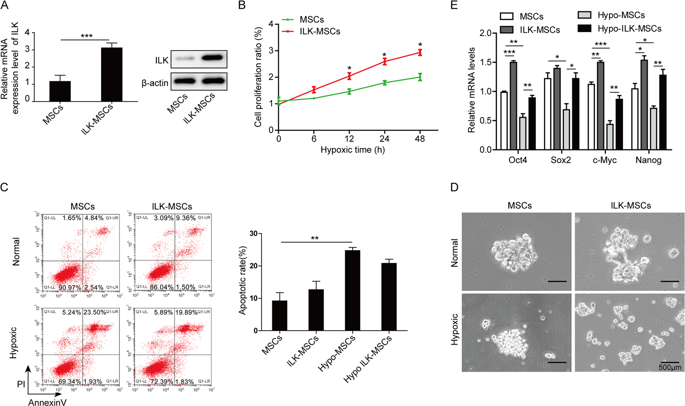当前位置:
X-MOL 学术
›
Gene Ther.
›
论文详情
Our official English website, www.x-mol.net, welcomes your
feedback! (Note: you will need to create a separate account there.)
ILK promotes survival and self-renewal of hypoxic MSCs via the activation of lncTCF7-Wnt pathway induced by IL-6/STAT3 signaling.
Gene Therapy ( IF 4.6 ) Pub Date : 2019-02-27 , DOI: 10.1038/s41434-018-0055-2 Qing Mao 1 , Xiu-Lin Liang 2 , Yu-Fu Wu 3 , Yi-Heng Pang 4 , Xiao-Jun Zhao 4 , Yong-Xiang Lu 4
Gene Therapy ( IF 4.6 ) Pub Date : 2019-02-27 , DOI: 10.1038/s41434-018-0055-2 Qing Mao 1 , Xiu-Lin Liang 2 , Yu-Fu Wu 3 , Yi-Heng Pang 4 , Xiao-Jun Zhao 4 , Yong-Xiang Lu 4
Affiliation

|
Mesenchymal stem cells (MSCs) have been applied in treating various diseases including myocardial infarction (MI) and achieved a bit of success; however, the decreased survival rate of MSCs after transplantation greatly limited the efficacy for cell therapy. How to improve the MSC survival rate in stem cell transplantation has undoubtedly become urgent and genetic engineering may be an ideal and feasible way. In this study, we explored the effects on MSCs survival and self-renewal by overexpression of integrin-linked kinase (ILK) in MSCs under hypoxic stimulation and aimed to reveal the molecular mechanisms from the point of paracrine function of MSCs. We first found that overexpression of ILK induced the expression and secretion of IL-6 increased significantly in MSCs under hypoxic stimulation, and the survival and self-renewal of MSCs exposed to hypoxia were enhanced after ILK overexpression. Then the activation of JAK2/STAT3 signaling was detected because of the increased IL-6, and an lncRNA, named lncTCF7, was upregulated remarkably, promoting the activation of Wnt pathway that was required for keeping cell viability and stemness of MSCs. Moreover, we further verified that inhibition of STAT3 signaling by WP1066 and silencing lncTCF7 expression eliminated the protective effects of ILK overexpression on cell survival and self-renewal of MSCs under hypoxic sitmulation. In conclusion, our results uncovered a novel function of ILK to promote MSC survival and self-renewal, suggesting more application potentials of MSC cell therapy on MI.
中文翻译:

ILK通过激活由IL-6 / STAT3信号转导的lncTCF7-Wnt途径来促进低氧MSC的存活和自我更新。
间充质干细胞(MSCs)已用于治疗多种疾病,包括心肌梗塞(MI),并取得了一些成功;然而,移植后MSC的存活率降低大大限制了细胞治疗的功效。如何提高干细胞移植中MSC的存活率已成为当务之急,基因工程可能是一种理想可行的方法。在这项研究中,我们探索了在缺氧刺激下过表达整合素连接激酶(ILK)在缺氧刺激下对MSC存活和自我更新的影响,并从旁分泌功能的角度揭示了其分子机制。我们首先发现在低氧刺激下,MSC中ILK的过度表达诱导了IL-6的表达和分泌显着增加,ILK过表达后,缺氧的MSCs的存活和自我更新得到增强。然后,由于IL-6的增加,检测到JAK2 / STAT3信号的激活,并显着上调了一个名为lncTCF7的lncRNA,从而促进了保持MSCs细胞活力和干性所需的Wnt途径的激活。此外,我们进一步证实了WP1066对STAT3信号的抑制和lncTCF7表达的沉默消除了ILK过表达对缺氧情景下MSC细胞存活和自我更新的保护作用。总之,我们的结果揭示了ILK促进MSC存活和自我更新的新功能,表明MSC细胞疗法在MI上有更多的应用潜力。然后,由于IL-6的增加,检测到JAK2 / STAT3信号的激活,并显着上调了一个名为lncTCF7的lncRNA,从而促进了保持MSCs细胞活力和干性所需的Wnt途径的激活。此外,我们进一步证实了WP1066对STAT3信号的抑制和lncTCF7表达的沉默消除了ILK过表达对缺氧情景下MSC细胞存活和自我更新的保护作用。总之,我们的结果揭示了ILK促进MSC存活和自我更新的新功能,表明MSC细胞疗法在MI上有更多的应用潜力。然后,由于IL-6的增加,检测到JAK2 / STAT3信号的激活,并显着上调了一个名为lncTCF7的lncRNA,从而促进了保持MSCs细胞活力和干性所需的Wnt途径的激活。此外,我们进一步证实了WP1066对STAT3信号的抑制和lncTCF7表达的沉默消除了ILK过表达对缺氧情景下MSC细胞存活和自我更新的保护作用。总之,我们的结果揭示了ILK促进MSC存活和自我更新的新功能,表明MSC细胞疗法在MI上有更多的应用潜力。此外,我们进一步证实了WP1066对STAT3信号的抑制和lncTCF7表达的沉默消除了ILK过表达对缺氧情景下MSC细胞存活和自我更新的保护作用。总之,我们的结果揭示了ILK促进MSC存活和自我更新的新功能,表明MSC细胞疗法在MI上有更多的应用潜力。此外,我们进一步证实了WP1066对STAT3信号的抑制和lncTCF7表达的沉默消除了ILK过表达对缺氧情景下MSC细胞存活和自我更新的保护作用。总之,我们的结果揭示了ILK促进MSC存活和自我更新的新功能,表明MSC细胞疗法在MI上有更多的应用潜力。
更新日期:2019-11-18
中文翻译:

ILK通过激活由IL-6 / STAT3信号转导的lncTCF7-Wnt途径来促进低氧MSC的存活和自我更新。
间充质干细胞(MSCs)已用于治疗多种疾病,包括心肌梗塞(MI),并取得了一些成功;然而,移植后MSC的存活率降低大大限制了细胞治疗的功效。如何提高干细胞移植中MSC的存活率已成为当务之急,基因工程可能是一种理想可行的方法。在这项研究中,我们探索了在缺氧刺激下过表达整合素连接激酶(ILK)在缺氧刺激下对MSC存活和自我更新的影响,并从旁分泌功能的角度揭示了其分子机制。我们首先发现在低氧刺激下,MSC中ILK的过度表达诱导了IL-6的表达和分泌显着增加,ILK过表达后,缺氧的MSCs的存活和自我更新得到增强。然后,由于IL-6的增加,检测到JAK2 / STAT3信号的激活,并显着上调了一个名为lncTCF7的lncRNA,从而促进了保持MSCs细胞活力和干性所需的Wnt途径的激活。此外,我们进一步证实了WP1066对STAT3信号的抑制和lncTCF7表达的沉默消除了ILK过表达对缺氧情景下MSC细胞存活和自我更新的保护作用。总之,我们的结果揭示了ILK促进MSC存活和自我更新的新功能,表明MSC细胞疗法在MI上有更多的应用潜力。然后,由于IL-6的增加,检测到JAK2 / STAT3信号的激活,并显着上调了一个名为lncTCF7的lncRNA,从而促进了保持MSCs细胞活力和干性所需的Wnt途径的激活。此外,我们进一步证实了WP1066对STAT3信号的抑制和lncTCF7表达的沉默消除了ILK过表达对缺氧情景下MSC细胞存活和自我更新的保护作用。总之,我们的结果揭示了ILK促进MSC存活和自我更新的新功能,表明MSC细胞疗法在MI上有更多的应用潜力。然后,由于IL-6的增加,检测到JAK2 / STAT3信号的激活,并显着上调了一个名为lncTCF7的lncRNA,从而促进了保持MSCs细胞活力和干性所需的Wnt途径的激活。此外,我们进一步证实了WP1066对STAT3信号的抑制和lncTCF7表达的沉默消除了ILK过表达对缺氧情景下MSC细胞存活和自我更新的保护作用。总之,我们的结果揭示了ILK促进MSC存活和自我更新的新功能,表明MSC细胞疗法在MI上有更多的应用潜力。此外,我们进一步证实了WP1066对STAT3信号的抑制和lncTCF7表达的沉默消除了ILK过表达对缺氧情景下MSC细胞存活和自我更新的保护作用。总之,我们的结果揭示了ILK促进MSC存活和自我更新的新功能,表明MSC细胞疗法在MI上有更多的应用潜力。此外,我们进一步证实了WP1066对STAT3信号的抑制和lncTCF7表达的沉默消除了ILK过表达对缺氧情景下MSC细胞存活和自我更新的保护作用。总之,我们的结果揭示了ILK促进MSC存活和自我更新的新功能,表明MSC细胞疗法在MI上有更多的应用潜力。











































 京公网安备 11010802027423号
京公网安备 11010802027423号